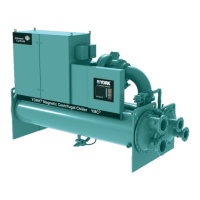JOHNSON CONTROLS
134
FORM 160.84-OM1
ISSUE DATE: 9/21/2017
SECTION 6 - PRINTING
Proceed with caution and use the following guidelines
if an unlisted printer is selected:
1. All must be capable of RS-232 serial communica-
tions.
2. Primary differences between printers involve the
formatting control codes required by the printer.
These codes are sent from the Control Center to
the printer. For example, Weigh -Tronix printers
require a control code to select 40 column width.
This same code is interpreted by the Okidata
printer as an instruction to print wide characters.
In some instances, a printer will ignore a code it
cannot interpret.
3. The Control Center requires a busy signal from
the printer when the printer receive buffer is full.
This causes the Control Center to momentarily
terminate data transmission until the printer can
accept more data. The busy signal polarity must
be asserted low when busy.
Okidata –
Models: OKIPOS 441
• Dimensions:
6.9″.widex9.64″.deepx5.98″.high
• Paper: 3.0 in. wide
• Type: Dot Matrix Impact
• Purchase: 800-OKIDATA
Spare printer Ribbon Okidata 52119001 Black
• P/N Charcoal P/N 62113901
Beige P/N 62113601
FIGURE 49 - OKIPOS PRINTER
LD16572
PRINTER CONNECTIONS
Connect the printer to the Control Center Microboard
as follows. Only one printer can be connected at a time.
TABLE 16 - OKIDATA OKIPOS 441
MICROBOARD PRINTER FUNCTION
J2-4 pin 3 Tx (data to printer)
J2-2 pin 20 DSR (busy signal from
printer)
J2-9 pin 7 Gnd
Cabinet Shield
Hardware required:
Cable
• #18 AWG stranded 50 ft. maximum length.
Connectors
Microboard
• None.Strip 1/4″insulationfromwireandinsert
into screw terminal block.
Printers
• Okidata - 25 pin plug DB-25P or equivalent; Shell
DB-C2-J9 or equivalent.
PRINTER SETUP
The selected printer must be configured as follows. Re-
fer to manual provided by printer manufacturer.
OKIDATA OKIPOS 441
1. With the printer power off, remove the two screws
which hold the RS232 Interface Module.
2. Pull the RS232 Interface Module out of the print-
er.
3. Set DIP switch SW2-2 to OFF to select 19200
BPS. Do not change any other switch settings.
4. Re-install the RS232 Interface Module and two
mounting screws.
5. Load paper and install the printer ribbon into the
printer.
6. Connect the printer cable to the printer and the
microboard.
7. Connect the printer power cable to the printer and
plug into a 100 to 240VAC power source.

